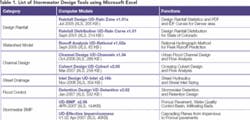Program offers Stormwater Computer Design Tools
By James C.Y. Guo, Ben Urbonas, Ken MacKenzie Sr., and Dave Lloyd
Starting in 1985, the Urban Drainage and Flood Control District (UDFCD) in Denver, CO, contracted the University of Colorado at Denver/HSC (CU-Denver) to develop a set of computing tools for stormwater system designs. The major goal of this effort was to convert the well-defined design routines in the Urban Storm Drainage Criteria Manual (UDFCD, 1969) into computer codes for easy, and accurate operations and use.
A technical review committee was set up that included administrators of public agencies, university researchers, and consulting engineers. The committee monitored the progress and steered the direction of the project. Each product developed was tested by the committee using real-world projects. The effort, which continued from 1985 through 1994, produced the first generation of stormwater computer design tools for watershed flood flow prediction, street drainage design, inlet sizing, culvert hydraulics, storm sewer simulation, and detention system design.
The programs feature on-screen data editing and provide on-screen reminders of design parameters. If the engineer chooses to deviate from the recommended design criteria, the program will raise a flag as a warning sign to the engineer and the project reviewers.
In 2001, UDFCD launched an extensive effort to update the design criteria manual (UDFCD, 2001). Most of the abovementioned computer tools were converted into Microsoft Office Excel spreadsheets that were uploaded to the UDFCD website (http://www.udfcd.org/downloads/down_technical.htm).
Structure of Stormwater Tools
These stormwater computer tools are structured as Microsoft Excel Workbooks. Each workbook consists of one or more sheets that are labeled by Sheet Tabs. The sequence of the sheets in each workbook follows the design logic and procedure, and each sheet provides a design calculation routine. For instance, the Detention Design Book begins with a title sheet that provides an introduction, the limits and capability of the workbook, and the list of contents. The design of a detention basin begins with the assessment of the required stormwater detention volume, which can be estimated by four different methods, depending on the goal of the detention basin under design.
The four methods are: (1) the modified FAA method, appropriate for estimating a basin storage volume serving a watershed smaller than 150 acres; (2) the hydrograph method, suitable for sizing detention volumes for larger watersheds; (3) the full-spectrum method for sizing volumes and release rates to produce discharges similar to the predevelopment condition; and (4) the capture volume method for estimating the stormwater quality storage volume in order to capture 80% of runoff volume for treatment.
Given a known storage volume, the workbook helps the engineer shape a basin using regular shapes that include triangular, rectangular, and elliptical shapes. Next, the engineer can click on Sheet Tabs to access the orifice, weir, or culvert sheets to design the outlet concrete vault with or without a trash tack. The last sheet in the Detention Design Book helps the engineer generate the detention basin’s stage-storage-outflow curve for hydrograph routing purposes.
Another example is the Inlet Design Workbook, which is composed of street hydraulics and inlet sizing. Street hydraulic calculations include: (1) street hydraulic capacity under minor and major storm events using various design criteria for gutter flows, and (2) street flow analysis for the design flow with consideration for inundated street crown, flood walls, and others. Given the known street flow distribution along the gutters for the design flow, the engineer can size a street inlet for stormwater collection. The options for street inlet design include: (1) grate inlet; (2) curb opening inlet; (3) combo inlet; or (4) slotted inlet in a sump or on a grade. All Excel Books are designed with on-screen help, reminders, and checks to ensure the entry is within the recommended range. A red flag is raised when any entry deviates from the design criteria.
The stormwater management research study coordinated by UDFCD and CU-Denver has been dedicated to the transfer of the latest academic developments and technology to engineering practice. The 2007 Excel Workbooks are the second generation of this long-term effort. All the design tools have been carefully reviewed by the technical committee for accuracy, best practicality, and usability. UDFCD, in conjunction with CU-Denver, continues to improve these products with the latest stormwater management techniques. The free, downloadable Workbooks have been widely accepted for stormwater management practices. UDFCD has also set up a user support group for public discussions and feedback to aid UDFCD and CU-Denver in implementing further improvements to the design methods and user tools.
About the Authors:
James C.Y. Guo is a Professor in the department of civil engineering at the University of Colorado-Denver/HSC. Ben Urbonas is a Manager, Ken MacKenzie Sr. is a Project Engineer, and Dave Lloyd is Executive Director, all with the Urban Drainage and Flood Control District, Denver, Colorado.

